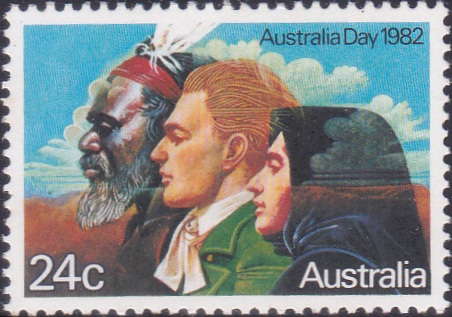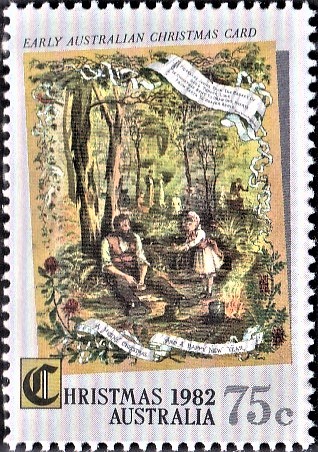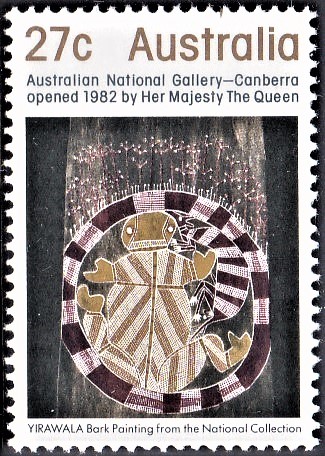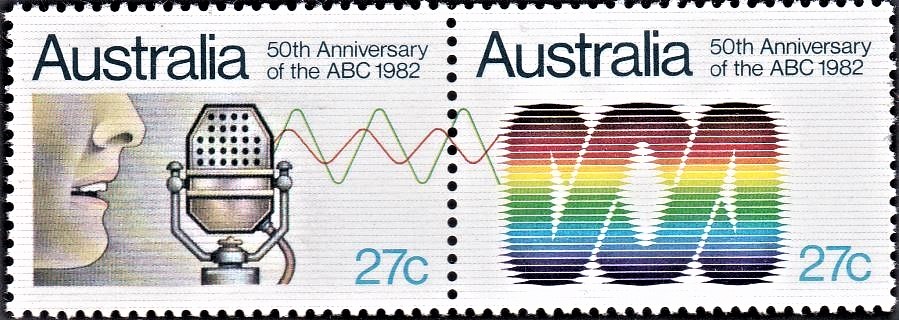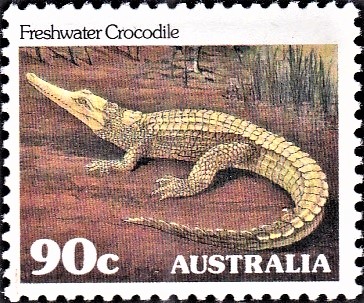
Australia Day 1982
A commemorative postage stamp on the Official National Day of Australia :
Issued on Jan 20, 1982
Issued for : Australia Day is celebrated each year on 26 January, the day on which the British flag was raised at Sydney Cove in 1788.
Design : The image on the Australia Day 1982 stamp symbolises three waves of migration : first by Aborigines entering from the islands of south-east Asia; many thousands of years later by colonists from Great Britain; and in post-war years by immigrants from Europe and other parts of the world. The stamp is intended to convey a sense of the unity of the Australian people, while recognising the diversity of their origins. This theme of the three great migration waves forming a complex, multicultural society was suggested for the Australia Day stamp by the National Australia Day Committee.
Designer : Brian Clinton [Mr Brian Clinton was born in Perth, Western Australia in 1942 and studied art at the Perth Technical College. He worked as an illustrator on a Perth Sunday newspaper, before moving to Melbourne where he joined Mr Ron fletcher (another artist who has designed stamps) in an art and design studio. Mr Clinton has received a number of portrait commissions, and his subjects include Victorian politicians. His stamp commissions for Australia Post Include ”famous Australian Racehorses”, ”fishing in Australia” and the “Marriage of HRH Charles, Prince of Wales & the Lady Diana Spencer“. Mr Clinton is a member of the Society of Illustrators, New York, and has exhibited with the Society. He is also interested in sculpture. In his leisure time he enjoys playing cricket and skiing. He lives in Melbourne with his wife and two children.]
Type : Stamp, Mint Condition
Colour : Multi colour
Denomination : 24 cents
Stamp size : 37.5 mm x 26 mm
Perforation : 13¼ x 13¾
Paper : litho–chromo stamp paper incorporating luminescence
Sheet content : 100 (issued)
Printing process : photolithography on a five–colour Heidelberg Speedmaster press
Printer : Cambec Press, Melbourne
About :
- When the first Aborigines arrived in Australia more than 40,000 years ago, sea levels were lower than at present, and the narrowest land gap may have entailed a sea voyage of as few as 80 kilometres. The Aborigines were well established across the continent at least 25,000 years ago. Ecological or environmental factors such as climate, diet and the geographic isolation of small communities are thought to have contributed to regional variations in physical characteristics such as stature and build. Cultural diversity is manifested in the many inter-related Aboriginal languages, and in the differing patterns of Aboriginal life in areas ranging from mild coastal regions to the arid waste of the inland.
- By the time of the arrival of the British colonists, the Aboriginal population comprised over 300,000 inhabitants, a society of seminomadic hunters and food collectors, living in accord with the demands of their environment and identifying themselves closely with the land. The world of these original Australians was disturbed irrevocably by the second great wave of settlement, beginning with the fleet of eleven ships which anchored in Sydney Cove in 1788.
- Some 750 convicts were transported in the first fleet, accompanied by British officers and marines with their wives and families, and the crews of the six transport ships, three store ships, and two men-o’-war. The first permanent European settlement was established in conditions of severe privation following a voyage of eight months. To the British colonists the new world seemed harsh, alien and uncongenial; provisions ran short, and their civilisation was many thousands of, miles away. From this unpromising beginning, however, the colony of New South Wales grew, attracting enterprising free settlers as vast pasturelands were discovered and occupied.
- Immigration was encouraged by the Australian colonial governments with inducements such as assisted passages and the regulation of land distribution, resulting in a modest but steady increase in population. The quiet tempo of life in this largely pastoral society was suddenly disrupted in the 1850s by the discovery of gold, first in New South Wales, and subsequently in Victoria. Gold brought boom conditions, as hundreds of thousands of immigrants converged on the Australian diggings. In the space of a few years the population soared to a total of over one million in 1858. The newcomers came from all parts of Europe, from America and Asia, but predominantly, as before, from the British Isles. Immigration after the gold rushes proceeded at a more conservative pace.
- War was the catalyst for the third great wave of migration to Australia. Millions of people were left homeless following the devastation of the Second World War. Australia was one of several countries to offer refuge, and immigrants were drawn from the war-ravaged countries of Europe. Britain remained the major source of post-war immigrants, but significant numbers also came from eastern Europe, Italy, Greece, Germany, the Netherlands, Austria and Yugoslavia. In more recent years Australia has also become the home of immigrants from middle-eastern countries, and from south-east Asia.
- The population of Australia was estimated in 1982 at 15 million people, double the total in 1945 when the Department of Immigration was established. Almost one fifth of all Australian residents were born overseas. This mingling of people with widely varying cultural backgrounds is producing a society with a character that is already recognisably and uniquely Australian.


